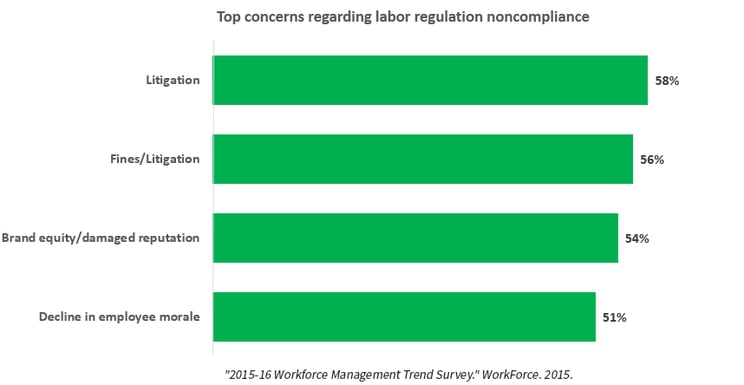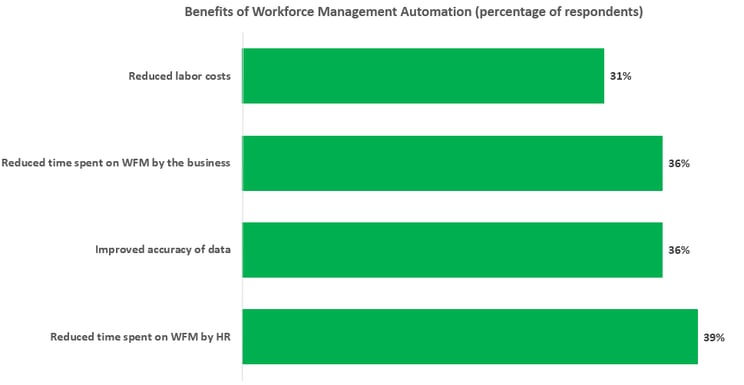
How much are your antiquated time and attendance tracking methods costing you? How much are you at risk because of noncompliance?
Regulation is expanding at all levels of government and litigation is becoming more frequent. Companies that do not have rigorous time and attendance processes are at risk. The sixth annual Workforce Management Trend Survey reported that the top concern of professionals and executives in the field was litigation over noncompliance.

They are concerned about more than the direct cost. In today’s connected world, news about noncompliance and payroll errors spread quickly. Employees can as easily tell the world about an issue as they can notify their HR representative or a supervisor.
Leaky Time and Attendance
Noncompliance risk is only part of the problem. If you haven’t updated your workforce management systems for a few years, you could be leaking money. If you are still using manual time tracking and spreadsheets, we are certain you are bleeding cash.
Here are a few examples we have seen from our personal experience in HR and Payroll. Does any of these seem familiar?
- Expecting employees to remember and write down on Monday what hours they worked the previous week. Not only are memories faulty -- people have a tendency to justify “adjustments” that may or may not be valid.
- Employees using proximity cards to punch out for co-workers who left early in the day.
- Inability to control overtime costs.
- Trying to sort out billable hours after a day of client emails and phone calls.
- Hundreds of hours in HR calculating and adjusting leave balances.
The case for automation and integration has never been stronger than it is today. As we see it, the reasoning is simple. Every manual data entry, transaction, and calculation is prone to human error. Automated processes built on rules will follow the rules every time, and user-friendly systems make them easy to manage.
Not so long ago, making the transition to totally automated and integrated time and attendance was a difficult choice. The solutions were expensive, hard to use, and difficult to maintain. That is no longer true.
Integrated Workforce Management
Today, integrated workforce management is the norm. The total cost of ownership is much lower, and many companies realize an immediate return on investment when they upgrade and integrate. In Aberdeen Group’s 2013 Time and Attendance survey, respondents reported a 32% decrease in time tracking errors and a 30% decrease in payroll processing errors. Three-quarters of organizations with workforce management solution implementations report significant payback—on average 6 percent to 10 percent—in less than a year.

Leaders in unified enterprise systems, like Workday, SAP, and Oracle, provide integrated platforms that enable companies to get complete control of their workforce costs with planning, scheduling, and time tracking tools. Companies then use the data from time and attendance to improve their planning and scheduling. Many organizations report reduced workloads, more accurate data, and reduced labor costs (Figure 2).
There are other benefits to automated time and attendance that will make your organization immediately more productive:
- Standardized processes across the organization create consistency and transparency that helps employees understand policies and builds trust in how employers apply them.
- Workforce management vendors provide updates to comply with regulatory changes as they occur. Standard reports make it easy to prove compliance with labor laws.
- Automated time tracking removes errors. Biometric inputs (fingerprints and face recognition) are now ubiquitous and very inexpensive. Managers can spend less time on timesheets and more time coaching people.
- Automated leave management keeps employees informed of their eligibility and status, helps managers plan for extended absences, and eliminates hours of tedious calculations in HR.
- For professional services organizations who rely on billed hours for revenue, new solutions capture time spent on client activity from schedules, emails, and phone calls.
Long-Term Benefits
What we have listed here are benefits that provide an immediate payoff. In the long term, companies see an increase in employee engagement and a more agile workforce. They also yield detailed strategic information about employee performance, project costs, and workforce trends.
There are a lot of specializations in time and attendance software for particular industries, but enterprise platforms like Workday provide standardized integrations that make it easy. There are solutions available for every company size and budget. We hope you will seize the opportunity to get control of your labor costs.
References
"Oracle HCM Solution—Time and Labor." Oracle Corporation. Accessed January 11, 2016.
"2015-16 Workforce Management Trend Survey." WorkForce. 2015. Accessed January 12, 2016.
Pixentia is a full-service technology company dedicated to helping clients solve business problems, improve the capability of their people, and achieve better results.


